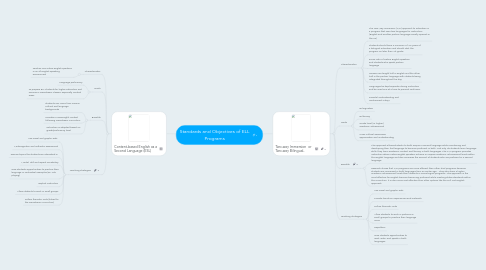
1. Content-based English as a Second Language (ESL)
1.1. Characteristics
1.1.1. Teaches non-native English speakers in an all English speaking environment
1.2. Goals
1.2.1. Language proficiency
1.2.2. To prepare ELL students for higher education and success in mainstream classes, especially content areas
1.3. Benefits
1.3.1. Students can come from various cultural and language backgrounds
1.3.2. Provides a meaningful context following mainstream curriculum
1.3.3. Instruction is adapted based on grade/proficiency level
1.4. Teaching Strategies
1.4.1. Use visual and graphic aids
1.4.2. Metacognition and authentic assessment
1.4.3. Discuss topics the students are interested in
1.4.4. Model, drill and repeat vocabulary
1.4.5. Give students opportunities to practice their language in contextual examples (ex. role playing)
1.4.6. Explicit instruction
1.4.7. Allow students to work in small groups
1.4.8. Follow thematic units (linked to the mainstream curriculum)
2. Two-way Immersion or Two-way Bilingual-
2.1. Characteristics
2.1.1. The Two-Way Immersion (TWI) approach to education is a program that uses two languages for instruction (English and another partner language-usually Spanish in the US)
2.1.2. Students should have a minimum of 4-6 years of a bilingual education and should start the program no later than 1st grade.
2.1.3. 50:50 ratio of Native English speakers and students who speak partner language
2.1.4. Lessons are taught half in English and the other half in the partner language with students being integrated throughout the day.
2.1.5. Languages be kept separate during instruction and be used one at a time to prevent confusion.
2.1.6. Parental understanding and involvement is key!
2.2. Goals
2.2.1. Bi-lingualism
2.2.2. Bi-literacy
2.2.3. Grade level (or higher) academic achievement
2.2.4. Cross cultural awareness, appreciation and understanding
2.3. Benefits
2.3.1. This approach allows students to both acquire a second language while maintaining and developing their first language to become proficient in both. Not only do students learn language skills, they learn academic content and literacy in both languages. The TWI program provides instruction where native English speakers achieve or surpass academic achievement levels within the English language and also increases the amount of students who are proficient in a second language.
2.3.2. Research shows that TWI programs are more efficient than other dual programs because students are immersed in both languages from an earlier age. They also show a higher academic achievement levels than students in monolingual programs. This approach is the most effective for English learners becoming proficient while meeting states standards within the curriculum. It is also more cost effective than other options like the Pull Out English approach.
2.4. Teaching Strategies
2.4.1. Use visual and graphic aids
2.4.2. Provide hands on experiences and materials
2.4.3. Follow thematic units
2.4.4. Allow students to work in partners or small groups to practice their language more
2.4.5. Repetition
2.4.6. Give students opportunities to read, write, and speak in both languages

